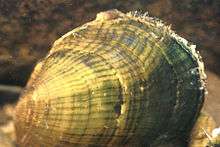Oyster mussel
| Oyster mussel | |
|---|---|
 | |
| Epioblasma capsaeformis | |
| Scientific classification | |
| Kingdom: | Animalia |
| Phylum: | Mollusca |
| Class: | Bivalvia |
| Order: | Unionoida |
| Family: | Unionidae |
| Genus: | Epioblasma |
| Species: | E. capsaeformis |
| Binomial name | |
| Epioblasma capsaeformis (I. Lea, 1834) | |
| Synonyms | |
|
Dysnomia capsaeformis I. Lea, 1834 | |
The oyster mussel (Epioblasma capsaeformis) is a rare species of freshwater mussel in the family Unionidae. This aquatic bivalve mollusk is native to Kentucky, Tennessee, Alabama, and Virginia in the United States. It has been extirpated from the states of Georgia[2] and North Carolina.[3] It is a federally listed endangered species of the United States.
This mussel was once widely distributed[4] and common[2] in the Cumberland and Tennessee River drainages, including many tributaries. It has declined 80% from its historical abundance.[1] It is now extirpated from the Cumberland River system and the main artery of the Tennessee River. It remains in the Nolichucky River of Tennessee and the Clinch River in Tennessee and Virginia.[4] Specimens once classified as this species that remain in the Duck River in Tennessee have now been classified as a separate species, Epioblasma ahlstedti.[5][6]
Like other freshwater mussels, this species reproduces by releasing its larvae, termed glochidia, which lodge in the gills of fish to develop into juvenile mussels.[7] Host fish species for this mussel include wounded darter (Etheostoma vulneratum), redline darter (E. rufilineatum), bluebreast darter (Etheostoma camarum), dusky darter (Percina sciera), banded sculpin (Cottus carolinae), black sculpin (Cottus baileyi), and mottled sculpin (Cottus bairdi).[4]
The main threat to this species is habitat alteration such as channelization and impoundments of waterways, increased silt, and pollution.[2]
This mussel is propagated in captivity.[7] Many juveniles have been released into appropriate habitat.[4]
References
- 1 2 Bogan, A.E. 2000. Epioblasma capsaeformis. 2011 IUCN Red List of Threatened Species. Downloaded on 25 September 2011.
- 1 2 3 Epioblasma capsaeformis. The Nature Conservancy.
- ↑ USFWS. Oyster mussel in North Carolina.
- 1 2 3 4 USFWS. Epioblasma capsaeformis Five-year Review. July 2011
- ↑ Jones, J.W., and R.J. Neves. 2010. "Descriptions of a new species and a new subspecies of freshwater mussels, Epioblasma ahlstedti and Epioblasma florentina aureola (Bivalvia: Unionidae), in the Tennessee River drainage, USA." The Nautilus 124(2):77-92.
- ↑ Jones, J. W., et al. (2006). A holistic approach to taxonomic evaluation of two closely related endangered freshwater mussel species, the oyster mussel Epioblasma capsaeformis and tan riffleshell Epioblasma florentina walkeri (Bivalvia: Unionidae). J. Mollus. Stud. 72 (3): 267-283.
- 1 2 Vincie, M. E. Development of a suitable diet for endangered juvenile oyster mussels Epioblasma capsaeformis (Bivalvia: Unionidae) reared in a captive environment. Master's Thesis. Virginia Tech.
